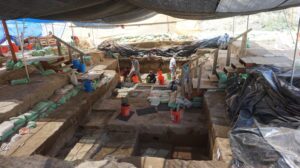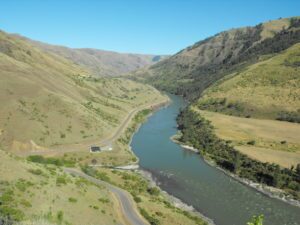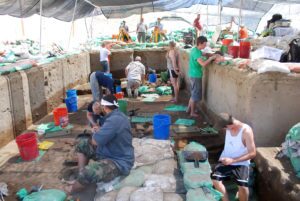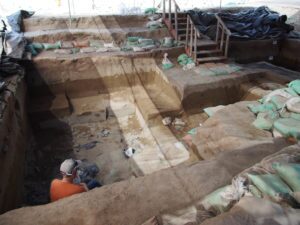 Cooper’s Ferry site Area A excavations at work 2018. Loren Davis, Oregon State University
Cooper’s Ferry site Area A excavations at work 2018. Loren Davis, Oregon State University American Association for the Advancement of Science and Oregon State University—Archaeological discoveries from the Cooper’s Ferry site in western Idaho indicate that humans migrated to and occupied the region by nearly 16,500 years ago. The findings expand the timing of human settlement in the Americas to a period predating the appearance of an ice-free corridor linking Beringia and the rest of North America and support the growing notion that the very first Americans likely landed upon the shores of the Pacific coast. How and when human populations first arrived and settled in the Americas remains debated. A longstanding and influential hypothesis proposes that travelers initially entered North America and parts beyond from eastern Beringia, by way of a deglaciated ice-free corridor that separated the Cordilleran and Laurentide ice sheets approximately 14,800 years ago. However, a small but growing body of research has shown that human populations were present and likely well-established south of the Late Pleistocene ice sheets long before such a passage; its proponents hypothesize a Pacific coastal migration route. Loren Davis and colleagues present new findings from Cooper’s Ferry that provide evidence of repeated occupation beginning between 16,560 to 15,280 years ago. Artifacts recovered from the site’s earliest contexts indicate the use of unfluted and stemmed stone projectile point technologies before the use of fluted, broad-based points of the widespread Clovis Paleoindian Tradition. According to Davis et al., the age, design and manufacture of Cooper’s Ferry’s distinctive stemmed points closely resemble features of artifacts found in Late Pleistocene archeological sites in northeastern Asia.
“The Cooper’s Ferry site is located along the Salmon River, which is a tributary of the larger Columbia River basin. Early peoples moving south along the Pacific coast would have encountered the Columbia River as the first place below the glaciers where they could easily walk and paddle in to North America,” Davis said. “Essentially, the Columbia River corridor was the first off-ramp of a Pacific coast migration route.
“The timing and position of the Cooper’s Ferry site is consistent with and most easily explained as the result of an early Pacific coastal migration.”
Cooper’s Ferry, located at the confluence of Rock Creek and the lower Salmon River, is known by the Nez Perce Tribe as an ancient village site named Nipéhe. Today the site is managed by the U.S. Bureau of Land Management.
The site includes two dig areas; the published findings are about artifacts found in area A. In the lower part of that area, researchers uncovered several hundred artifacts, including stone tools; charcoal; fire-cracked rock; and bone fragments likely from medium- to large-bodied animals, Davis said. They also found evidence of a fire hearth, a food processing station and other pits created as part of domestic activities at the site.
Over the last two summers, the team of students and researchers reached the lower layers of the site, which, as expected, contained some of the oldest artifacts uncovered, Davis said. He worked with a team of researchers at Oxford University, who were able to successfully radiocarbon date a number of the animal bone fragments.
The results showed many artifacts from the lowest layers are associated with dates in the range of 15,000 to 16,000 years old.
“Prior to getting these radiocarbon ages, the oldest things we’d found dated mostly in the 13,000-year range, and the earliest evidence of people in the Americas had been dated to just before 14,000 years old in a handful of other sites,” Davis said. “When I first saw that the lower archaeological layer contained radiocarbon ages older than 14,000 years, I was stunned but skeptical and needed to see those numbers repeated over and over just to be sure they’re right. So we ran more radiocarbon dates, and the lower layer consistently dated between 14,000-16,000 years old.”
The dates from the oldest artifacts challenge the long-held “Clovis First” theory of early migration to the Americas, which suggested that people crossed from Siberia into North America and traveled down through an opening in the ice sheet near the present-day Dakotas. The ice-free corridor is hypothesized to have opened as early as 14,800 years ago, well after the date of the oldest artifacts found at Cooper’s Ferry, Davis said.
“Now we have good evidence that people were in Idaho before that corridor opened,” he said. “This evidence leads us to conclude that early peoples moved south of continental ice sheets along the Pacific coast.”
Davis’s team also found tooth fragments from an extinct form of horse known to have lived in North America at the end of the last glacial period. These tooth fragments, along with the radiocarbon dating, show that Cooper’s Ferry is the oldest radiocarbon-dated site in North America that includes artifacts associated with the bones of extinct animals, Davis said.
The oldest artifacts uncovered at Cooper’s Ferry also are very similar in form to older artifacts found in northeastern Asia, and particularly, Japan, Davis said. He is now collaborating with Japanese researchers to do further comparisons of artifacts from Japan, Russia and Cooper’s Ferry. He is also awaiting carbon-dating information from artifacts from a second dig location at the Cooper’s Ferry site.
“We have 10 years’ worth of excavated artifacts and samples to analyze,” Davis said. “We anticipate we’ll make other exciting discoveries as we continue to study the artifacts and samples from our excavations.”
____________________________

Coopers Ferry site, left center, view east. Loren Davis, Oregon State University
____________________________

Cooper’s Ferry project camp 2014. Loren Davis, Oregon State University
____________________________

Cooper’s Ferry Site 2013 Area A looking east. Loren Davis, Oregon State University
____________________________

Cooper’s Ferry site Area A excavations at work 2018. Loren Davis, Oregon State University
____________________________

Cooper’s Ferry site Area A overview Aug 2018. Loren Davis, Oregon State University
____________________________
Article Source: American Association for the Advancement of Science and Oregon State University news releases.





One comment on “Archaeological site reveals humans arrived in the Americas more than 16,000 years ago”